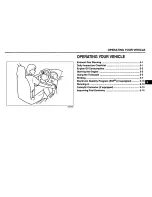
Tire Information
To safely operate your vehicle, your tires must be of the proper type and size, in
good condition with adequate tread, and properly inflated.
n
Inflation Guidelines
• Properly inflated tires provide the best combination of handling, tread life,
and comfort. Refer to the driver’s doorjamb label or see SPECIFICATIONS
for the specified pressure.
• Underinflated tires wear unevenly, adversely affect handling and fuel
economy, and are more likely to fail from overheating.
• Overinflated tires make your vehicle ride harshly, are more prone to road
hazards, and wear unevenly.
• Every day before you drive, look at each of the tires. If one looks lower
than the others, check the pressure with a tire gauge.
• Measure the air pressure when tires are cold. This means the vehicle has
been parked for at least 3 hours, or driven less than 1 mile (1.6 km). If
necessary, add or release air until the specified pressure is reached. If
checked when hot, tire pressure can be as much as 4-6 psi (30-40 kPa,
0.3-0.4 kgf/cm
2
) higher than checked when cold.
• At least once a month or before long trips, use a gauge to measure the
pressure in all tires, including the spare. Even tires in good condition can
lose 1-2 psi (10-20 kPa, 0.1-0.2 kgf/cm
2
) per month.
MAINTENANCE
200 |
n
Inspection Guidelines
Every time you inflate the tires, check for the following:
• Any damage to tires, including bumps, bulges, cuts, splits, or cracks in
the side or tread.
• Remove any foreign objects and inspect for air leaks. Replace tires if you
see fabric or cord.
• Uneven or excessive tread wear. Have a dealer check the wheel
alignment.
• Cracks or other damage around the valve stems.
Vehicles with optional spare tire kit: Check the spare tire pressure once a
month or before long trips.
Using tires that are excessively worn or improperly inflated can cause a
crash in which you can be seriously hurt or killed.
Follow all instructions in the owner’s manual regarding tire inflation and
maintenance.
n
Wear Indicators
The groove where the wear indicator is
located is 1/16 inch (1.6 mm) shallower
than elsewhere on the tire. If the tread
has worn so low that the indicator is
exposed, replace the tire. Worn out
tires have poor traction on wet roads.
MAINTENANCE
| 201








































